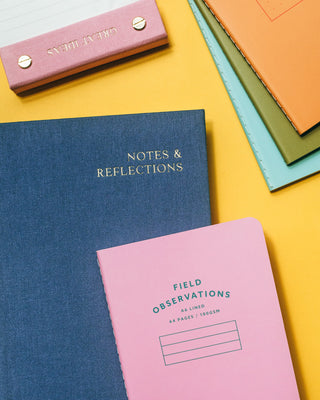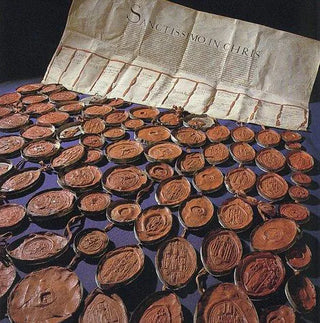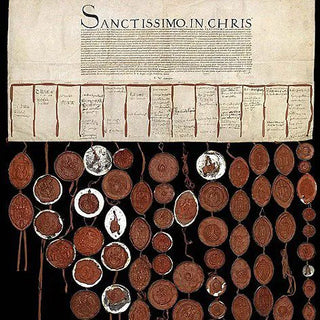The Beginners Guide to the History of Sealing Wax
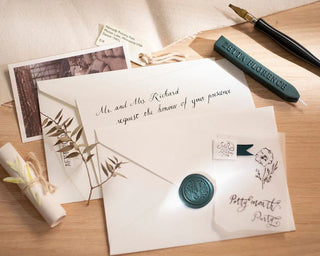
The Beginners Guide to the History of Sealing Wax
Sealing wax dates back to Ancient Rome before the invention of paper. They would use wax to sign clay tablets as a form of authentication. During the Middle Ages, people would use wax seals to sign contracts, agreements and letters instead of an actual signature.
Wax sealing was associated with class and power. Royals, lords, monarchs and bishops all possessed an official seal. Many would have their stamp made into a signet ring they wore for security. When the official passed away, the ring would either be passed down to an heir or destroyed to avoid identity theft.
Below is the Sanctissimo In Chris, a letter written to Pope Clement VII in 1530. This letter demanded the Catholic Church annul Henry VIII’s first marriage to Catherine of Aragon.
The letter was signed by 81 noblemen using their wax seals to show their support of the annulment and was consequential in England’s break from Catholocism under Henry VIII’s reign.
The Purpose of Wax Seals
As wax seals became more commonly used for letter writing, they allowed senders to seal their letters before the invention of envelopes, and then later, to seal envelopes before envelope glue. Wax made it difficult for the document to be opened without breaking the seal.
This form of security would confirm that nobody opened the document or letter. The wax seal would also help to verify the sender’s identity, with most families putting their initials in the stamp.
Etiquette of Wax Sealing
Over the history of wax sealing, wax seals, have carried different meanings and etiquette. The contents of a letter or the sender’s position often denoted the wax seal’s type and colour. For example, it was distasteful to use a large wax seal, the smaller and glossier the seal, the better.
The quality of the wax would also play into the etiquette of sending a letter and the sender’s class. A cheap red wax would often look purplish or brownish after it was melted. This colour was due to additives such as rosin, bole or vermillion. Merchants in the 18th Century began manufacturing lower-quality wax and selling it as higher quality by rolling the sticks in a false coat.
An appropriate wax seal would have your monogram and crest but should never include the family’s coat of arms. A plain seal with the sender’s initials was best for common service, particularly for letters of business. Lovers would often use perfumed seals or perfumed envelopes. However, using a perfumed seal and an envelope was distasteful.
Meanings behind the colour of wax seals
As different wax colours began to flood the market in the 1800s, the meaning behind the colour of wax seals started to take shape. Here are a few examples:
- It was customary for men to use a red seal, and women would use a rose colour
- If you were mourning or writing to someone in mourning, the letter would have a black seal.
- Varying shades of blue would express all the gradients of passion
- A pink seal was appropriate when the sender was offering their congratulations
- Violet seals were appropriate for sympathy
- Wedding invitations were traditionally sealed with white wax
- Dinner invitations were often sealed with chocolate wax
- Private letters were sealed with dark green or red
- Engaged loves would use ruby seals when writing to one another
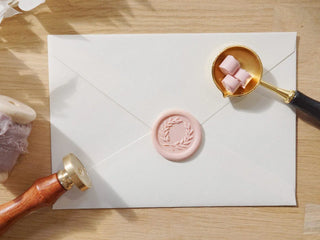
Manufacturing wax seals
At the beginning of the industrial revolution, manufacturing took a modern twist. By the mid-nineteenth century, specially designed machines streamlined production, leading to pre-gummed envelopes. Wax sealing began to decline as it became more impractical and costly. This decline continued through the 20th century until its recent resurgence.
The resurgence of wax stamps
With the resurgence of wax stamps, they are now recognised as a post-modern form of correspondence. Those who practice letter writing with wax seals seek to connect with traditional and historical practices. Many are calling on the need for more handwritten communication.
In a world where most of us spend multiple hours a day online, we are left craving slow and tangible modes of communication. Handwriting a letter and adding a wax seal is the perfect way to get off your device and sit with an age-old practice.
Wax seals have also become incredibly popular with event invitations. This is perhaps due to the timeless and traditional aesthetic that pairs so well with rituals such as weddings. Sealing a gift or an invitation with wax is a more personal and thoughtful touch.
Furthermore, the craft gives joy to the receiver. We would all agree there is nothing like receiving a handwritten letter from a loved one and the excitement of breaking open a fresh wax seal. Fortunately, crafting handwritten letters, envelopes and invitations will never go out of style.
To start wax sealing your letters, check out our complete range of stamping wax that will give your next letter or invitation a unique touch.
